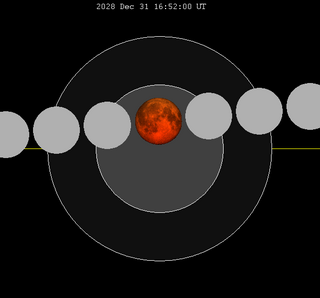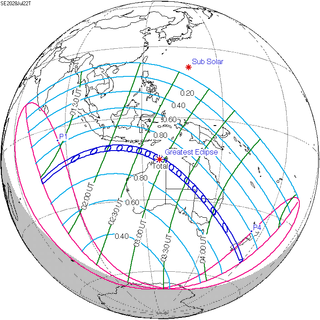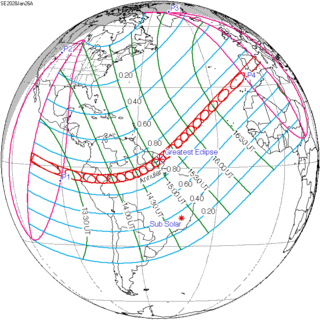
A total lunar eclipse occurred from 5:27 to 11:06 UTC on 21 December 2010, coinciding with the date of the Winter solstice in the Northern Hemisphere and Summer solstice in the Southern Hemisphere. It was visible in its entirety as a total lunar eclipse in North and South America, Iceland, Ireland, Britain and northern Scandinavia.

A total lunar eclipse will take place on Sunday, December 31, 2028. It will occur during a blue moon and is the first such eclipse to happen on New Year's Eve and New Year's Day since December 2009, and the first total lunar eclipse on New Year's Day in history. The next such eclipse will be on December 2047.

A partial lunar eclipse was visible on 31 December 2009. It was the last and largest of four minor lunar eclipses in 2009. This lunar eclipse was also notable, because it occurred during a blue moon and was near perigee. The next eclipse on New Year's Eve and blue moon will occur on 31 December 2028.

A partial lunar eclipse occurred on 26 June 2010, the first of two lunar eclipses in 2010. At maximum eclipse, 53.68% of the Moon was covered by the Earth's shadow.

A penumbral lunar eclipse took place at the Moon's ascending node on 11 February 2017, the first of two lunar eclipses in 2017. It was not quite a total penumbral lunar eclipse. It occurred the same day as comet 45P/Honda–Mrkos–Pajdušáková made a close approach to Earth. It also occurred on the Lantern Festival, the first since 9 February 2009. Occurring only 4.4 days after perigee, the moon's apparent diameter was larger.

A total lunar eclipse will take place on August 7, 2036. The southern tip of the Moon will pass through the center of the Earth's shadow. This is the last central lunar eclipse of Saros cycle 129.

A total lunar eclipse will take place between Monday and Tuesday, June 25-26, 2029. A central total eclipse lasting 1 hour and 41 minutes 53 seconds will plunge the full Moon into deep darkness, as it passes right through the centre of the Earth's umbral shadow. While the visual effect of a total eclipse is variable, the Moon may be stained a deep orange or red color at maximum eclipse. It will be able to be seen from most of the Americas, Western Europe and Africa. The partial eclipse will last for 3 hours and 39 minutes 32 seconds in total.
A total lunar eclipse took place on Tuesday, July 6, 1982, the second of three total lunar eclipses in 1982, and the only one that was in the descending node. A dramatic total eclipse lasting 1 hour and 46 minutes plunged the full Moon into deep darkness, as it passed right through the centre of the Earth's umbral shadow. While the visual effect of a total eclipse is variable, the Moon may have been stained a deep orange or red colour at maximum eclipse. This was a great spectacle for everyone who saw it. The partial eclipse lasted for 3 hours and 56 minutes in total.
A partial lunar eclipse took place on Friday, July 17, 1981, the second of two lunar eclipses in 1981. The Earth's shadow on the Moon was clearly visible in this eclipse, with 55% of the Moon in shadow; the partial eclipse lasted for 2 hours and 43 minutes.

A partial lunar eclipse took place on Saturday, December 21, 1991, the last of four lunar eclipses in 1991. The moon grazed the northern edge of the umbral shadow. It occurred near perigee, and as described, such event was known as a supermoon.

A partial lunar eclipse occurred on 19 November 2021. The eclipse occurred towards a micromoon. This was the longest partial lunar eclipse since 18 February 1440, and the longest until 8 February, 2669; however, many eclipses, including the November 2022 lunar eclipse, have a longer period of umbral contact at next to 3 hours 40 minutes. It was often referred to as a "Beaver Blood Moon" although not technically fulfilling the criteria for a true blood moon (totality).

A total lunar eclipse occurred on 26 May 2021. A lunar eclipse occurs when the Moon moves into the Earth's shadow. This can occur only when the Sun, Earth, and Moon are exactly or very closely aligned with Earth between the other two, which can only happen at a full moon. The eclipsed moon appeared as a faint red disk in the sky due to a small amount of light being refracted through the Earth's atmosphere; this appearance gives a lunar eclipse its nickname of a Blood Moon.
A partial lunar eclipse will take place on Wednesday, 18 September 2024, the second of two lunar eclipses in 2024 and the final partial lunar eclipse of Lunar Saros 118.

A partial lunar eclipse will take place on Thursday, July 6, 2028.
A partial lunar eclipse took place on Tuesday, March 13, 1979, the first of two lunar eclipses in 1979. The Moon was strikingly shadowed in this deep partial eclipse which lasted 3 hours, 17 minutes and 40.6 seconds, with 85.377% of the Moon in darkness at maximum.
A partial lunar eclipse took place on Thursday, May 13, 1976, the first of two lunar eclipses in 1976, the second being a penumbral lunar eclipse on November 6, 1976. At maximum eclipse, a small bite out of the Moon should have been visible. The eclipse lasted for 1 hour, 15 minutes and 23.8 seconds, with just 12.17% of the Moon in shadow at maximum. Occurring only 1.1 days after perigee, the Moon's apparent diameter 5.4% larger than average.
A total lunar eclipse took place on Sunday, January 30, 1972, the first of two lunar eclipses in 1972. The moon entered the Earth's penumbral shadow at 30 January 1972 08:03:12.5 UTC and exited at 30 January 1972 13:43:37.9 UTC. The moon entered the Earth's umbral shadow at 30 January 1972 09:11:38.4 UTC and exited at 30 January 1972 12:35:03.1 UTC. Totality lasted 34 minutes, 47.7 seconds, between 10:35:57.4 UTC and 11:10:45.1 UTC. The moon was 6.6 days before apogee, making it 1.6% smaller than average, only 0.2% larger than the July 1972's lunar eclipse.
A partial lunar eclipse occurred on Tuesday, July 25, 1972 and Wednesday, July 26, 1972, the second of two lunar eclipses in 1972 with an umbral eclipse magnitude of 0.54271. A partial lunar eclipse occurs when the Earth moves between the Sun and Moon but the three celestial bodies do not form a straight line in space. When that happens, a small part of the Moon's surface is covered by the darkest, central part of the Earth's shadow, called the umbra. The rest of the Moon is covered by the outer part of the Earth's shadow called the penumbra. The moon's apparent diameter was 3.2 arcseconds smaller than the January 30, 1972 lunar eclipse.

A total solar eclipse will occur on Saturday, July 22, 2028. The central line of the path of the eclipse will cross the Australian continent from the Kimberley region in the north west and continue in a south-easterly direction through Western Australia, the Northern Territory, south-west Queensland and New South Wales, close to the towns of Wyndham, Kununurra, Tennant Creek, Birdsville, Bourke and Dubbo, and continuing on through the centre of Sydney, where the eclipse will have a duration of over three minutes. It will also cross Queenstown and Dunedin, New Zealand. Totality will also be viewable from two of Australia's external territories: Christmas Island and Cocos (Keeling) Island.

An annular solar eclipse will occur on Wednesday, January 26, 2028. A solar eclipse occurs when the Moon passes between Earth and the Sun, thereby totally or partly obscuring the image of the Sun for a viewer on Earth. An annular solar eclipse occurs when the Moon's apparent diameter is smaller than the Sun's, blocking most of the Sun's light and causing the Sun to look like an annulus (ring). An annular eclipse appears as a partial eclipse over a region of the Earth thousands of kilometres wide.





































